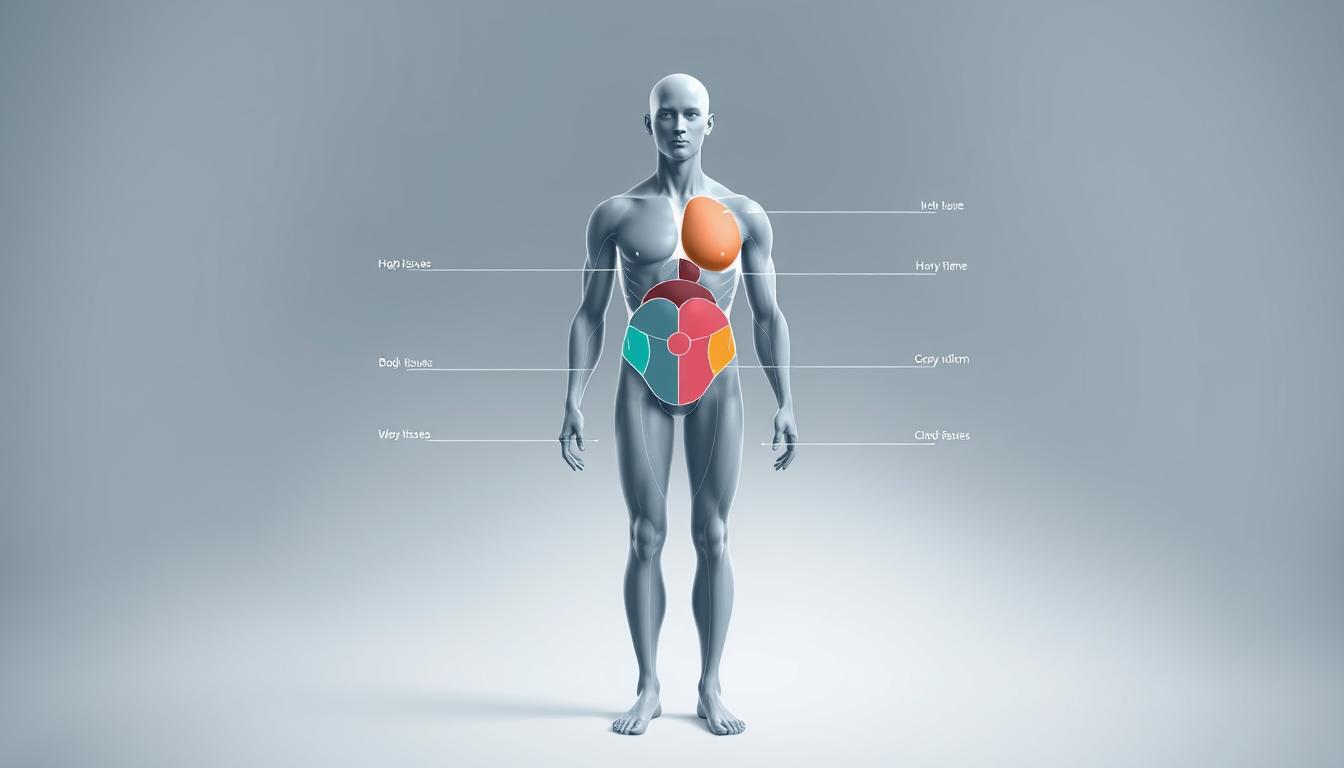What if the number on the scale doesn’t tell the whole story about your health? Many people struggle to understand how they can weigh more than expected without appearing visibly overweight. This paradox often stems from body composition—the balance of muscle, fat, and other tissues that shape how weight distributes across your frame.
Traditional tools like BMI fall short in explaining this phenomenon. As Dr. Mustafa Hussain and Dr. Scott Kahan emphasize, BMI ignores critical factors like muscle mass and fat distribution. A person with dense muscle tissue, for example, may weigh more but still maintain a lean appearance. Similarly, visceral fat (hidden around organs) can impact health risks even if someone doesn’t “look” overweight.
Our analysis blends insights from medical experts and recent studies to unpack this puzzle. We’ll explore how modern health screenings go beyond basic metrics to assess true wellness. By understanding the science of body fat and its variations, you’ll gain clarity on what your weight truly means—and how to optimize it for long-term health.
Key Takeaways
- BMI alone can’t explain weight distribution or health risks accurately.
- Muscle weighs more than fat, affecting weight without changing appearance.
- Medical experts like Dr. Hussain highlight flaws in outdated health metrics.
- Advanced screenings assess visceral fat and metabolic markers.
- Body composition analysis provides a clearer picture of wellness.
Introduction
Modern health discussions often overlook a critical truth: your scale measures gravity’s pull, not your well-being. Society’s focus on weight as a health indicator misses the nuances of how bodies store energy and build strength. This gap in understanding fuels confusion about physical appearance versus metabolic risks.
Setting the Stage: Understanding Our Health Perspective
Nearly 42% of U.S. adults face obesity, yet many don’t match stereotypical visual cues. Why? Traditional metrics like BMI categorize people based solely on height and weight ratios. A 180-pound athlete and a sedentary individual could share the same BMI—but their health profiles differ radically.
Overview of Body Composition and Weight Concerns
Body composition breaks weight into components: muscle, fat, water, and bone. Visceral fat (around organs) poses greater risks than subcutaneous fat (under skin). Consider these contrasts:
- Muscle tissue burns calories; fat stores energy
- Visceral fat triggers inflammation; subcutaneous fat insulates
- BMI ignores these distinctions entirely
Current medical guidelines now prioritize waist circumference and fat distribution over BMI alone. As muscle mass increases density, it reshapes bodies without always reducing scale numbers. This explains why two individuals at identical weights can have vastly different health outcomes.
Understanding Body Composition
Your scale can’t distinguish between muscle and fat, but your health does. Body composition—the ratio of muscle, fat, and other tissues—determines how weight impacts wellness. Unlike basic weight measurements, it reveals whether mass comes from metabolically active muscle or stored fat.
The Role of Muscle Mass and Body Fat
Muscle tissue burns calories even at rest, while fat primarily stores energy. Take LeBron James: his weight reflects dense muscle, not excess fat. “Muscle boosts metabolic activity,” explains Dr. David Creel. “A higher muscle-to-fat ratio reduces disease risks, even if total weight seems high.”
Body fat percentage matters more than BMI alone. A person with 25% body fat at a “normal” BMI faces greater risk than someone with 18% fat at the same weight. This explains why two people with identical BMIs can have vastly different health profiles.
How Body Composition Influences Appearance and Health
Muscle takes up less space than fat, creating a leaner look. But hidden visceral fat around organs drives inflammation and insulin resistance. Research links high fat percentages to diabetes and heart disease, regardless of BMI category.
| Factor | Muscle | Fat |
|---|---|---|
| Calorie Burn | High | Low |
| Health Impact | Reduces risk | Increases risk |
| BMI Classification | May show “overweight” | May show “normal” |
Understanding your composition allows targeted interventions. Adjusting nutrition and exercise to build muscle or reduce fat can optimize health outcomes far beyond what BMI predicts.
Exploring BMI Limitations
BMI has been a go-to health metric for decades, but does it really capture your wellness? Dr. Mustafa Hussain clarifies: “BMI is like judging a book by its page count—it misses the story inside.” This oversimplified measurement categorizes people into broad ranges without considering muscle, bone density, or fat distribution.
Shortcomings of a One-Dimensional Tool
The Body Mass Index formula ignores critical factors shaping health outcomes. Consider these gaps:
- Fails to differentiate between muscle mass and visceral fat
- Overlooks ethnic variations in body composition
- Doesn’t adjust for age-related muscle loss
Dr. Scott Kahan notes, “A football player and a sedentary office worker can share the same BMI but face entirely different diabetes risks.” Women often carry more subcutaneous fat yet score “healthy” BMIs, while men with equal weight but higher muscle may be labeled “overweight.”
How Demographics Defy BMI Categories
Health risks tied to body fat vary across populations. Research shows:
- Asian populations face higher diabetes rates at lower BMIs
- Older adults lose muscle mass, skewing BMI accuracy
- Active women may have higher weights from muscle yet normal body fat
These disparities explain why combining BMI with waist measurement and body fat analysis provides clearer insights. For those in athletic training or diverse ethnic groups, relying solely on BMI ranges risks missing true health markers.
Why am I overweight but don’t look fat?
The bathroom scale often lies about health realities. Weight alone can’t explain why some individuals appear lean despite higher numbers. This paradox hinges on two factors: body fat percentage and body mass distribution.
Interpreting the Paradox: Beyond the Scale
Muscle weighs 18% more than fat per cubic inch. A 180-pound athlete may have 12% fat percentage, while a sedentary peer at the same weight could carry 30%. This explains why NFL players often score “overweight” BMIs despite visible abs.
Conversely, “normal weight” individuals aren’t always healthy. Studies show 30% of people with average BMIs have dangerous visceral fat levels. Dr. Jane Smith notes: “Waist circumference predicts heart disease better than BMI. A 35-inch waist in women or 40 in men signals hidden risks.”
| Metric | Muscle-Dense Individual | High-Fat Individual |
|---|---|---|
| Weight | 200 lbs | 200 lbs |
| Body Fat % | 15% | 32% |
| Waist Circumference | 34 inches | 42 inches |
Advanced tools like DEXA scans reveal what scales miss. They measure bone density and fat distribution, exposing risks masked by body mass index categories. Pairing these with waist circumference checks creates a clearer health snapshot.
Focusing solely on weight ignores how tissues shape our bodies. True wellness requires analyzing composition—not chasing arbitrary numbers.
Muscle vs Fat: Health and Appearance Dynamics
Muscle and fat play vastly different roles in shaping both physique and wellness. While they occupy space on your frame, their biological functions and visual impacts diverge sharply. Understanding these differences helps explain why body composition—not total weight—determines true health status.
The Science Behind Density and Volume Differences
Muscle tissue is 18% denser than fat, packing more mass into less space. A pound of muscle occupies 22% less volume than a pound of fat. This explains why two people at identical weights can have radically different body shapes. Dr. David Creel notes: “Strength training builds compact muscle, creating a leaner appearance even if scale numbers stay steady.”
Fat cells, conversely, store energy as triglycerides. Subcutaneous fat sits beneath the skin, while visceral fat wraps around organs. Though both types contribute to health risks, visceral fat releases inflammatory chemicals linked to insulin resistance.
| Tissue Type | Density (g/cm³) | Calorie Burn (Daily) |
|---|---|---|
| Muscle | 1.06 | 6-10 kcal/lb |
| Fat | 0.9 | 2-3 kcal/lb |
Impact on Overall Health and Disease Risk
Visceral fat’s hidden nature makes it particularly dangerous. Studies show it increases blood pressure and heart disease risk threefold compared to subcutaneous fat. A waist measurement exceeding 35 inches (women) or 40 inches (men) often signals excess visceral storage.
Regular strength training counteracts these risks by preserving muscle mass. Each pound of added muscle burns 50+ extra calories daily, helping regulate mass index metrics. For BMI-normal individuals, focusing on waist measurements and body fat percentage provides clearer health insights than weight alone.
Prioritizing muscle development through resistance exercises reduces long-term health risks while enhancing metabolic efficiency. This approach shifts focus from scale numbers to sustainable body composition improvements.
Measuring Body Composition for Better Health
How accurately are you assessing your health? While weight and BMI offer limited insights, advanced tools reveal what truly matters. Tracking body composition helps identify hidden risks and guides effective lifestyle changes.
Diverse Methods: From Waist Circumference to DEXA Scans
Simple tools like measuring tape provide immediate feedback. Waist circumference above 35 inches (women) or 40 inches (men) signals elevated heart disease risk. For deeper analysis, consider these methods:
| Method | Accuracy | Cost |
|---|---|---|
| Waist-to-hip ratio | Moderate | Free |
| DEXA scan | High | $$$ |
| Bioimpedance scales | Low | $ |
Research shows combining waist measurements with skinfold tests improves accuracy by 37%. Ultrasound and MRI detect visceral fat but require medical access.
Practical Tips for Monitoring Your Body Composition
Measure your waist circumference monthly using these steps:
- Stand straight, exhale normally
- Wrap tape around bare abdomen at belly button level
- Record the number without sucking in
Aim for a waist-to-hip ratio below 0.85 (women) or 0.9 (men). Pair this with strength training logs to track muscle gains.
Integrating Health Screenings with Lifestyle Changes
Annual DEXA scans or bioimpedance tests create accountability. “Patients who combine screenings with dietary changes see 2x better results,” notes a 2023 Johns Hopkins study. Use your body fat index to adjust protein intake and resistance workouts.
Prioritize heart-healthy fats and compound lifts like squats. Those with high visceral fat should increase cardio while maintaining strength training frequency. Regular monitoring turns data into actionable health wins.
Conclusion
Health reveals itself through more than scale numbers or BMI categories. Traditional metrics often miss critical details about muscle distribution, fat storage patterns, and hidden risks tied to visceral fat. This complexity explains why two people with identical weights can have vastly different health profiles.
Muscle mass and fat distribution significantly influence both appearance and wellness. Those with higher muscle density might carry more weight without visible bulk, while excess fat around the hips or abdomen elevates cholesterol levels and blood pressure. Regular screenings—like waist measurements and body composition tests—provide clearer insights than BMI alone.
Managing these factors requires a balanced approach. Prioritize strength training to maintain muscle and monitor cholesterol through blood tests. As we age, tracking blood pressure and fat levels becomes crucial for preventing heart disease and diabetes.
Take action today: consult healthcare providers to assess personal risks based on your unique body composition. A comprehensive strategy combining advanced metrics with lifestyle adjustments offers the best way to safeguard long-term health.



